What is the Difference Between Hay and Straw?
Homesteading tips that help you know with confidence that you are using the right roughage in each situation.
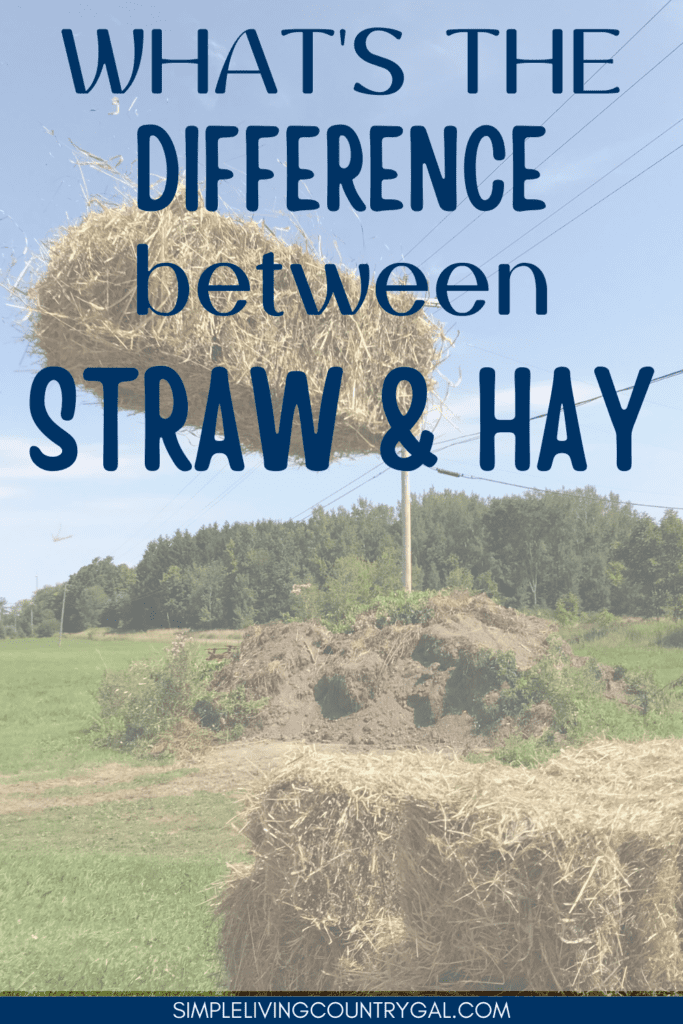
When I first started out as a homesteader, I was not quite prepared for all the things I would need to know. Let’s be honest: in the beginning, my main concern was the health and well-being of my animals. I went from a dog to a herd of goats, a group of pigs, and a flock of chickens, so the overwhelm was definitely there. And my only goal at that point was to simply keep them alive!
And while the health and care of our animals is incredibly important, I soon learned that so much more goes into having a successful Homestead.
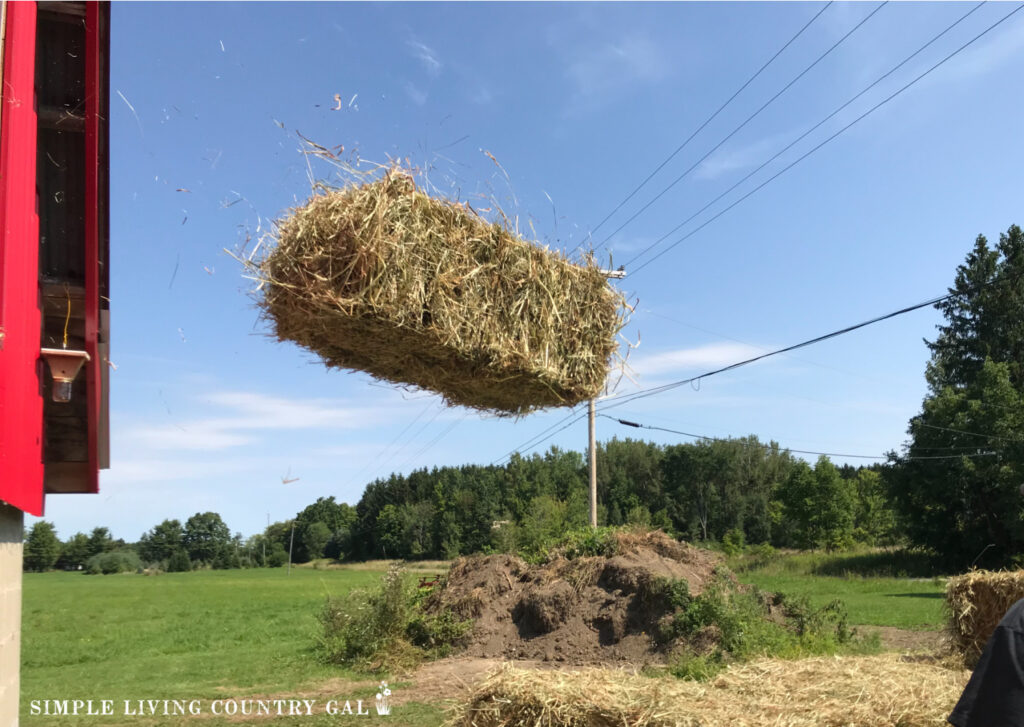
Most of the things I’ve learned over my last 18 years of homesteading came from good old-fashioned trial and error. Usually, I would do something, get the worst possible outcome, and learn a valuable lesson in the process.
This is exactly what happened when I decided to use hay in my garden one summer, instead of straw. But more on that in a bit.
Before I tell this sad yet comical tale, we first need to go over a few of the basics. If you did not know, hay and straw are two completely different things, and by the time you are done reading, my hope is that you will be better prepared on what to use to feed your animals, to bed your animals, to use in chicken coops, and what works best in your compost bin and garden.
Is straw just dried hay?
Straw is completely different than hay and here is a super brief overview of each.
- Straw is dried grain stalks without any seeds or leaves and that means it also has no nutritional value.
- Hay is cut grass and includes all the parts, including the seeds, leaves, and stems. Hay gives much of the nutrition needed for your livestock.
The Difference Between Straw and Hay
Yes, there is a difference between hay and straw, and if you’re not careful, you can have awful side effects and issues that you may find yourself dealing with for years to come. The main reason is the inclusion of seeds.
First, let’s go over the definitions of each in more detail so you fully understand what each is and how it plays a role on a homestead.
What is hay?
Hay is grass, legumes, or other herbaceous plants that have been cut and then dried. Hay contains all parts of the plant or grass meaning nothing is removed during cutting this includes any other plants that are growing as well as weeds.
Because everything is included, hay contains nutrients needed for feeding and maintaining livestock.
SLCG Pro Tip: I can always tell how good hay is by the smell. The better the hay, the more grassy it smells. If it smells dusty or musty, it is not good hay for our goats.
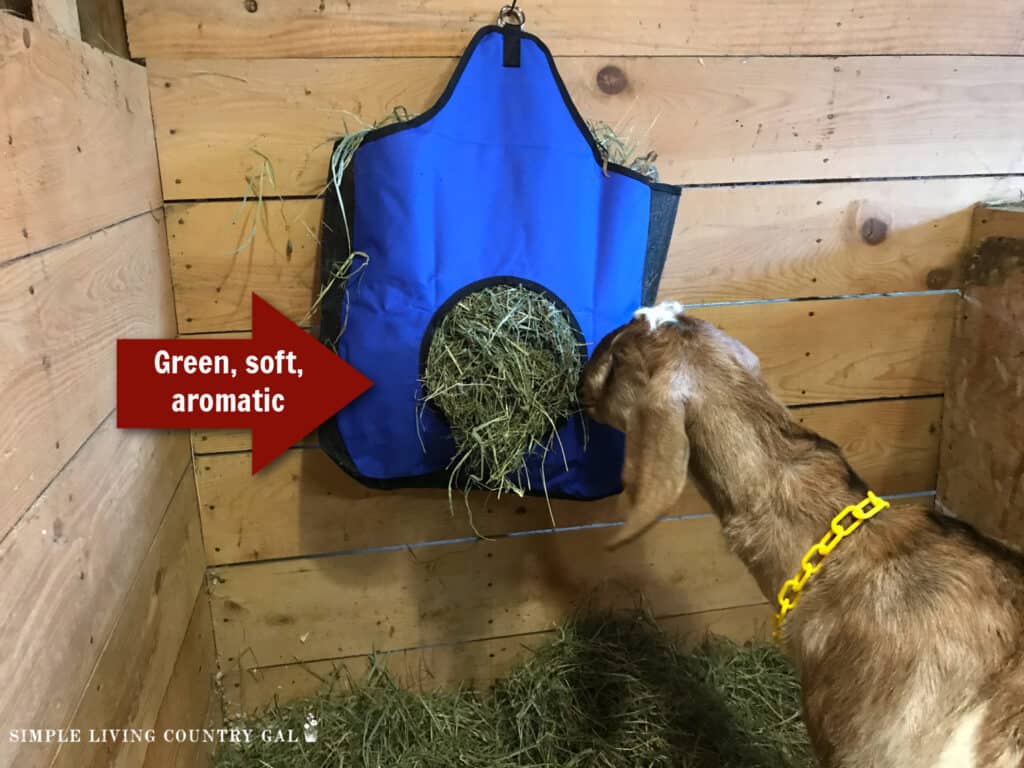
What is straw?
Straw is very different from hay because it does not contain the seeds, grain, or chaff (the seed’s casing) of the plant. Because of this, there is no nutritional value in straw which is why it is not used as food for livestock.
Since straw does not contain seeds, it can be used in landscaping, gardens, and compost bins. Straw bales are also recommended for straw bale gardening.
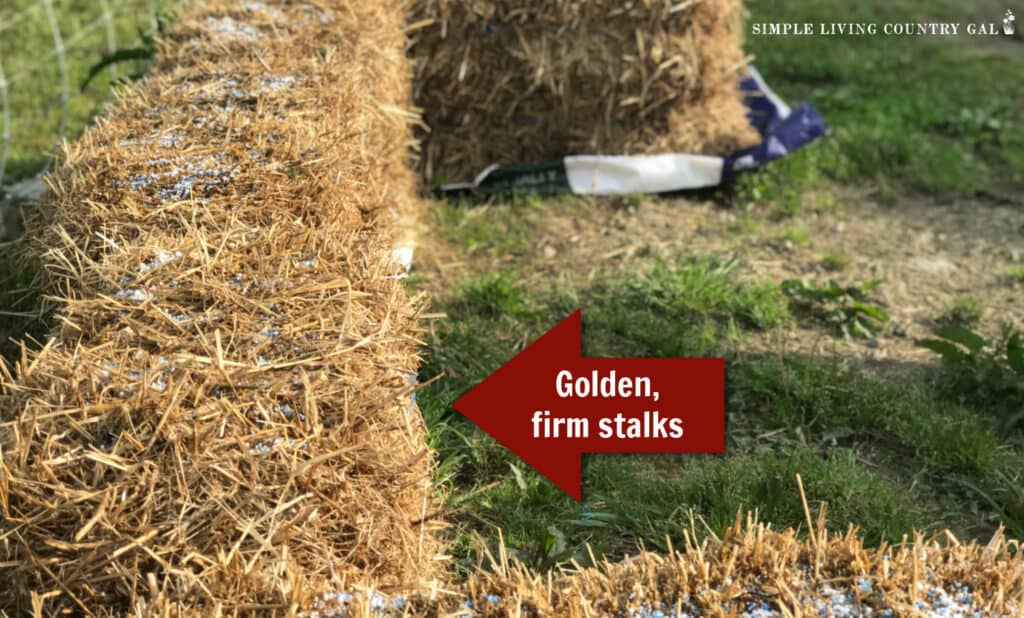
Both straw and hay are harvested the same way.
- First, it is mowed or cut.
- Once cut, it is left to lay where it is in long rows, allowing it to dry for a day or two in the warm sunshine.
- Once the cut is dry, it is then gathered up into bales.
- These bales are then protected from the weather, particularly rain, by either a plastic wrap or stored in a well-ventilated barn or shelter.
What animals eat hay?
Just about every livestock eats hay, including large livestock such as horses and cows, medium-sized livestock such as goats and sheep, and small livestock such as rabbits.
Using hay as food
Since hay is the entire plant and therefore contains all the nutritional value of that plant, the main purpose of hay is to feed livestock animals. When feeding animals, the main goal is nutrition, and that is why hay is used for feed and not straw.
If possible, it is always best to let your animals graze on fresh pasture year-round; however, if you live in an area where weather prevents that or you do not have access to a pasture, you will need to have a supply of good-quality hay.
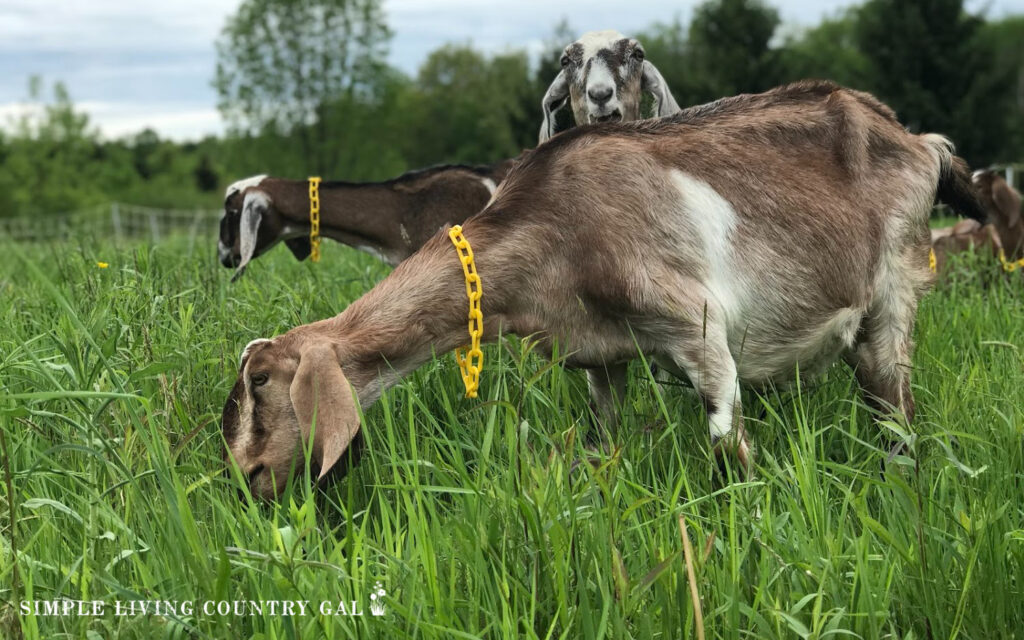
When choosing hay to feed your livestock, it is important to know what grasses your animals eat so you can choose the best cuts for each breed.
Goats –
Goats need protein, especially dairy goats, and for that reason, Alfalfa hay is at the very top of their list. However, finding this type of hay in some areas can be hard as it is not widely grown.
You can also feed goats Timothy hay and/or Orchard grass and supplement with alfalfa chaffhaye or alfalfa pellets if needed, and actually, this is what we do on our own homestead. Learn more on Raising Dairy Goats here.
Sheep –
Sheep prefer to eat finer grass, so for that reason, you will want to look for grassier hay or, if you have access to it, a leafy Alfalfa hay.
Cows –
When feeding cows look for Alfalfa mixed with Grass hay. You can also feed Legume hay as well. The hay you feed your cattle will depend on whether they are beef or dairy as each has different nutritional requirements.
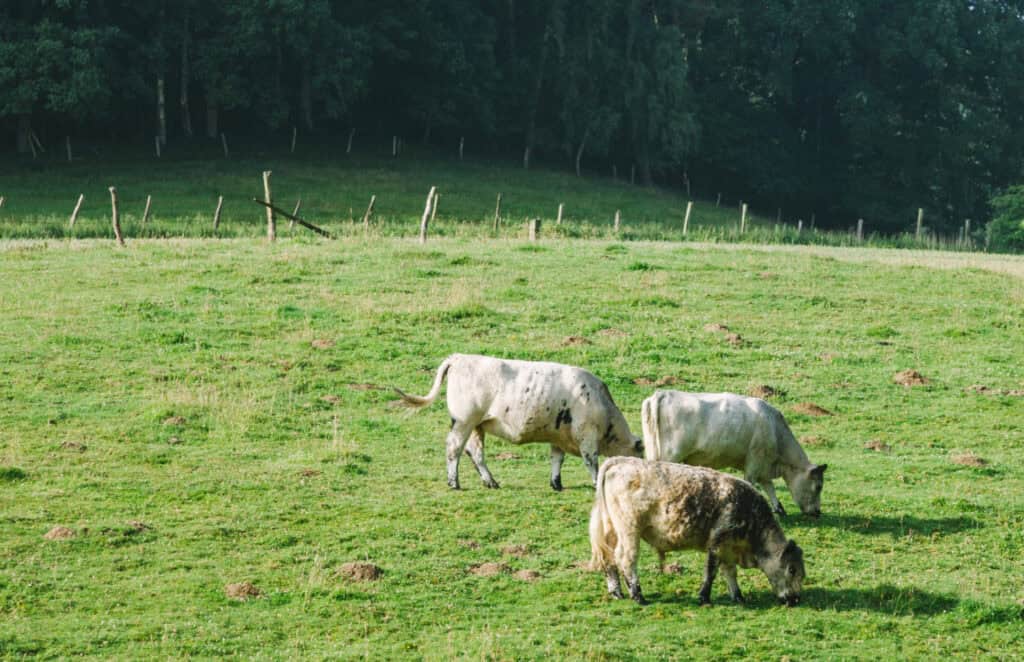
Horses –
When feeding horses, you will want to look for Timothy hay, Bermuda grass hay, Oat hay, Alfalfa hay, and Clover/grass hay. Try to find hay that does not contain a lot of dirt or dust, as this can cause coughing issues in horses.
Rabbits –
Rabbits need to have access to hay that is clean and completely dry. Alfalfa and Timothy are both good options to feed your rabbits. Read How to Raise Rabbits for Beginners for even more tips.
SLCG PRO TIP: Never feed moldy hay to your animals. Moldy had will not only run the risk of abortions in livestock but can also make your animals gravely ill or even kill them. Yes, some cows can handle a bit of mold, but they still run the risk of aborting if they are pregnant.
Always look for good quality, clean, and dust-free hay to feed to your animals. The better the hay, the better the nutrition. Yes, you may need to pay more for better quality, but it will be cheaper now rather than paying a vet bill for sick livestock later on.
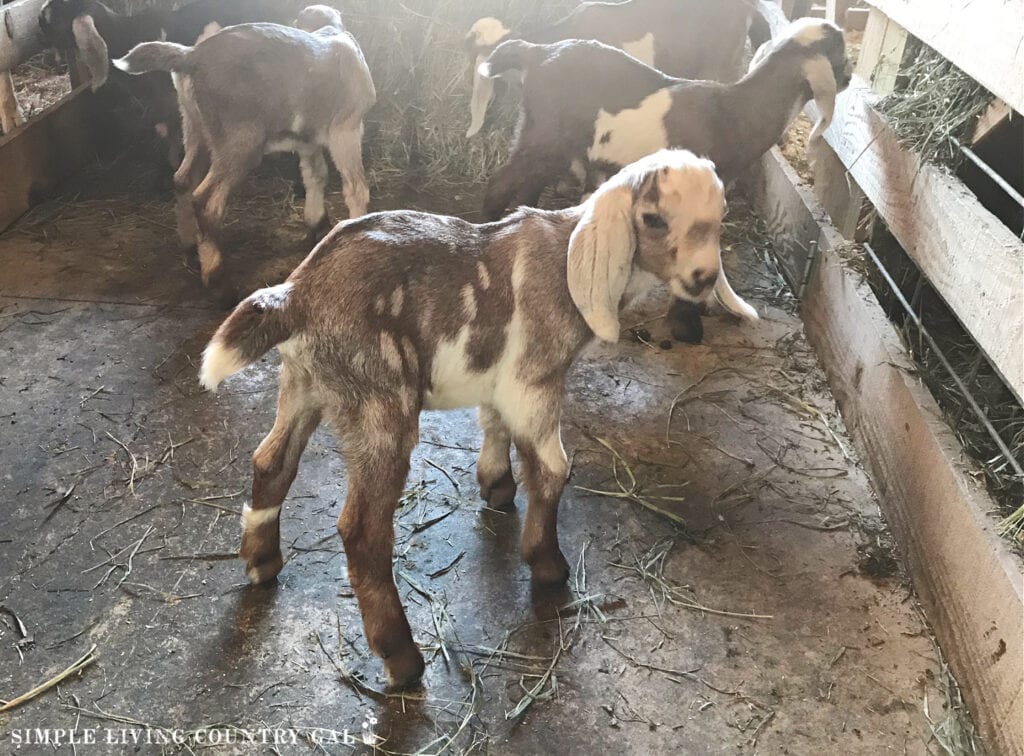
Livestock Feeding Resources:
What is the cost of hay?
Finding hay to purchase for your animals can be a little tricky when you are a new homesteader. For us, we called our local County Extension office as well as the local feed mill. These two places will inform you of any hay auctions in your area or local farmers you can contact for purchase.
SLCG PRO TIP: If you are starting with new animals, look for others in your area to reach out to. We looked for other goat farmers in our area and even purchased a few goats from them when starting out.
The information they shared with us was more valuable than any books we could find because our wet area is a unique struggle with goats. Our new goat friends were able to share inside tips on feed, housing, and care that served us for many years to come.
The cost of hay will depend on a few different factors. Where you live, the quality of the cut, and what number the cut is. Let’s look at each in more detail.
#1. Your area –
If you live in an area that grows the specific hay you need, you will pay less than you would in an area that does not. Ask around if you are not sure what hay is local to where you live.
Also, if you have a bad spring and summer, hay may be harder to get that year, driving the prices up. This does not happen often, but it is something to keep in mind when setting your annual homestead budget.
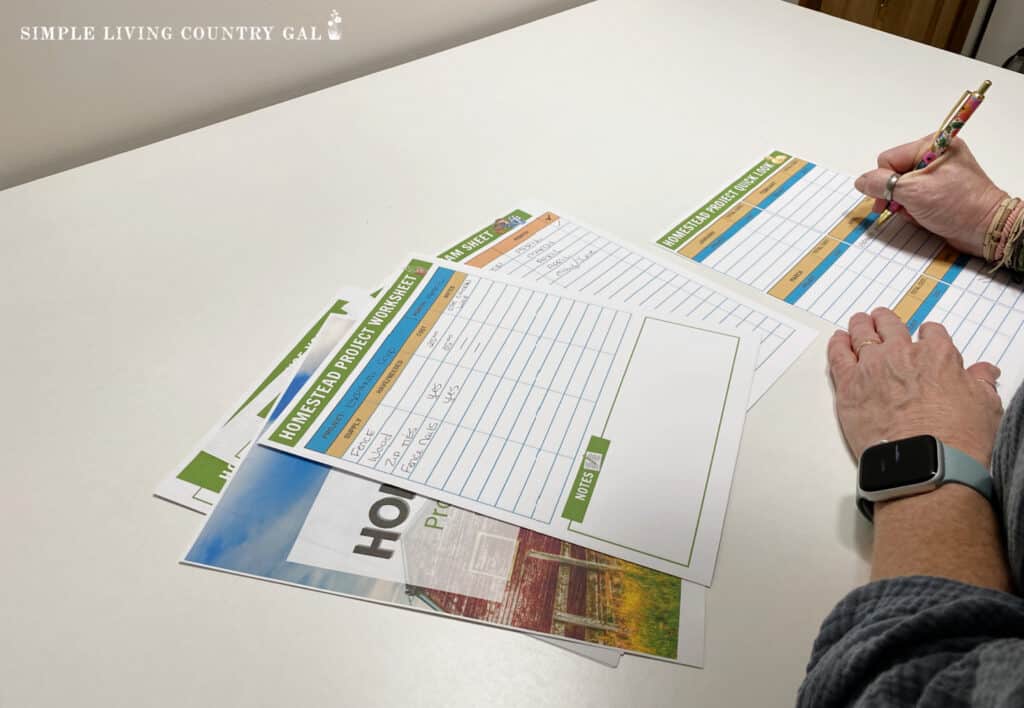
#2. The number of the cut–
There are several cuts that happen during each season. Please note that the cut times I have listed below are for our area in Pennsylvania and may not reflect specifically to you.
- 1st cut hay – Done in the spring and usually the cheapest to buy. It is a dryer cut of hay and tends to be thicker as well. FYI – When feeding first cut hay to goats, you will need to watch them for cuts in their mouths that can sometimes happen when poked with dry, sharp hay stems. This is something that commonly happens and is usually not an issue, but I do want you to be aware so you can administer first aid if needed.
- 2nd cut hay – Done in early summer and a better all-around cut of hay. This is what you will want to buy, if you can find it/afford it, for wintering your animals.
- 3rd cut hay – Done in mid-summer and a very lush and rich cut that is great for winter feedings of pregnant animals, such as goats.
- 4th cut hay – Done only sporadically as it depends on the weather. We do not feed 4th cut to our animals as we have yet to find a good quality in our area for this cutting.
#3. The quality of hay –
The better the quality of hay, the more you can expect to spend. First cut will be less expensive than 2nd cut, and so on. Also, some pastures have more weeds than others meaning there will be more weeds in the hay bales.
Do your research and keep notes of hay you have purchased, from where, and the quality so you can use this valuable resource year after year.
When do you need to up the quality of your hay?
I suggest feeding better cuts of hay to very young animals, pregnant animals, or any livestock you are milking. Another scenario is if you have any animals that are recovering from an ailment or other issue. Up the quality of the feed to help them better recover and heal.
Sizes of Hay
Depending on where you live will determine the size of bales that are available. The most common sizes of bales are.
- Small square bales – (even though they are rectangles we always called them squares) These bales are usually tied with two strings and measure about 36x19x16. You can expect these bales to weigh anywhere from 40-70 pounds each. This size is the most common and the most easily found.
- Large square bales – These bales are usually tied with three strings and measure about 44x22x15. You can expect these bales to weigh anywhere from 100 pounds or more. These bales are more for larger farms and/or homesteads.
- Round bales – These are HUGE bales and should only be purchased for very large (sometimes commercial-sized) herds of animals. Round bales are very heavy and cannot be moved by hand. They weigh anywhere from 1000-2000 pounds.
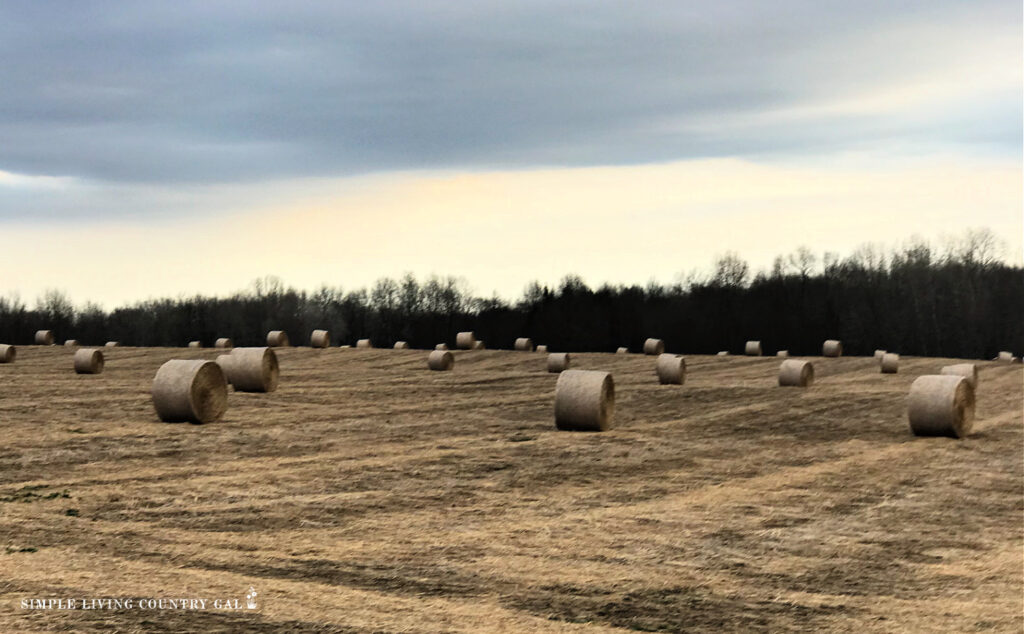
Storing hay for winter use
A task that is on most homesteads is filling the hay area that you can use during the winter months to feed to your livestock. For larger livestock such as cows and horses, you may need to use round bales that are covered in plastic. This will allow you to keep the bales outdoors as it is protected from the weather.
For medium and small animals, you will want to have your bales in a shelter. We use a corner of our barn to store our winter hay and this area can hold about 50 bales that will get us through a little over half of the winter season.
Be sure to keep your hay up off the ground to ensure it stays dry. Wet hay can get moldy, and feeding moldy hay to any animals is something you do not want to do.
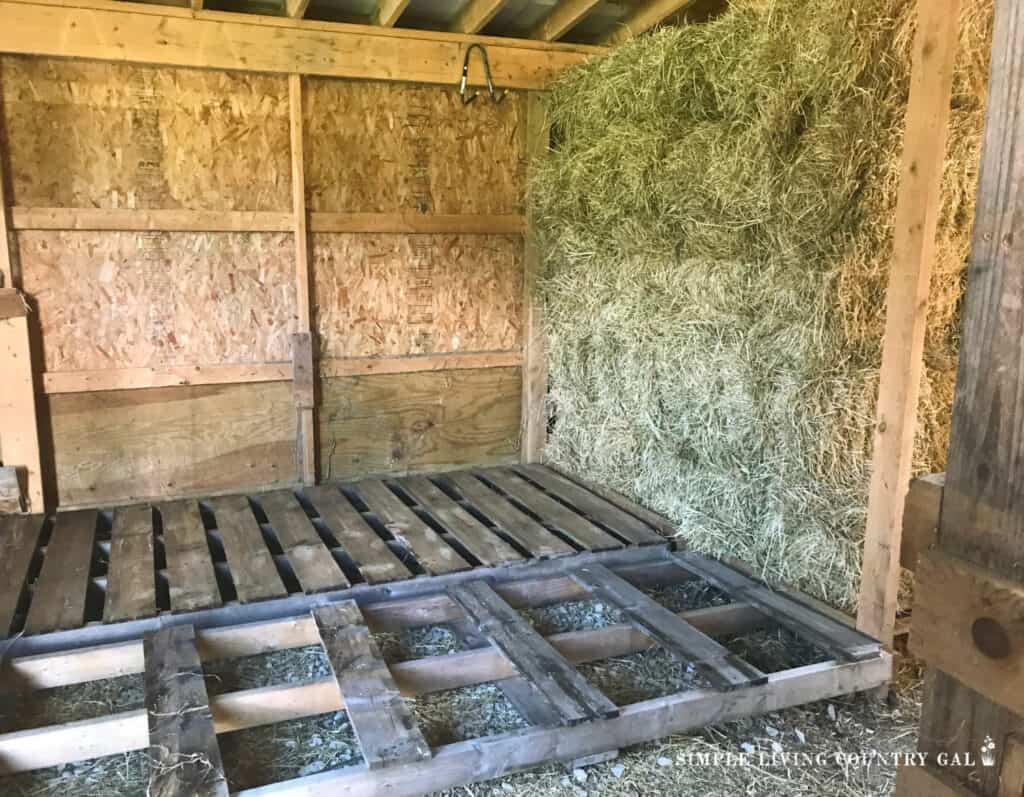
When and why do you use straw?
Since straw only contains the stem of the plant and not the seeds or chaff, it has little to no nutritional value. For that reason, straw is mainly used in gardening, for bedding, and landscaping projects. Using straw will keep weeds and other unwanted growth out of the garden, allowing just the intended plant to grow.
Another common use for straw is as bedding for your livestock, in pens, or in your chicken coop or nesting boxes.
SLCG PRO TIP: It is always a good rule of thumb to use straw as bedding with your animals. Using hay to bed your animals runs the risk of them eating soiled hay, which can cause worms in many ruminants.
Homesteading Books We Love:
Heaven’s Harvest Survival Seed Bank Kit (Over 25,000) Fruit & Vegetable Non-GMO Heirloom Seeds for Planting a 3+ Acre Home Garden. 100% Secure: Emergency Weather-Proof Bucket (1-Pack)


Using straw around the homestead
To remember when to use straw, keep this tip in mind. Straw is for maintenance and hay is for food.
#1. Using straw in the garden
One of the most important parts of any garden is the water. No, not the fertilizer or even the soil, although those factors are quite important, I still firmly believe that water will make or break what you grow. If you water too much, or too little, or at the wrong time or in the wrong way, your garden will be lackluster at best.
That is why mulching with straw is so helpful to gardeners no matter where they live. When you use straw to mulch around your plants you will keep the soil wet longer which is the very best way to grow large and healthy fruits and veggies.
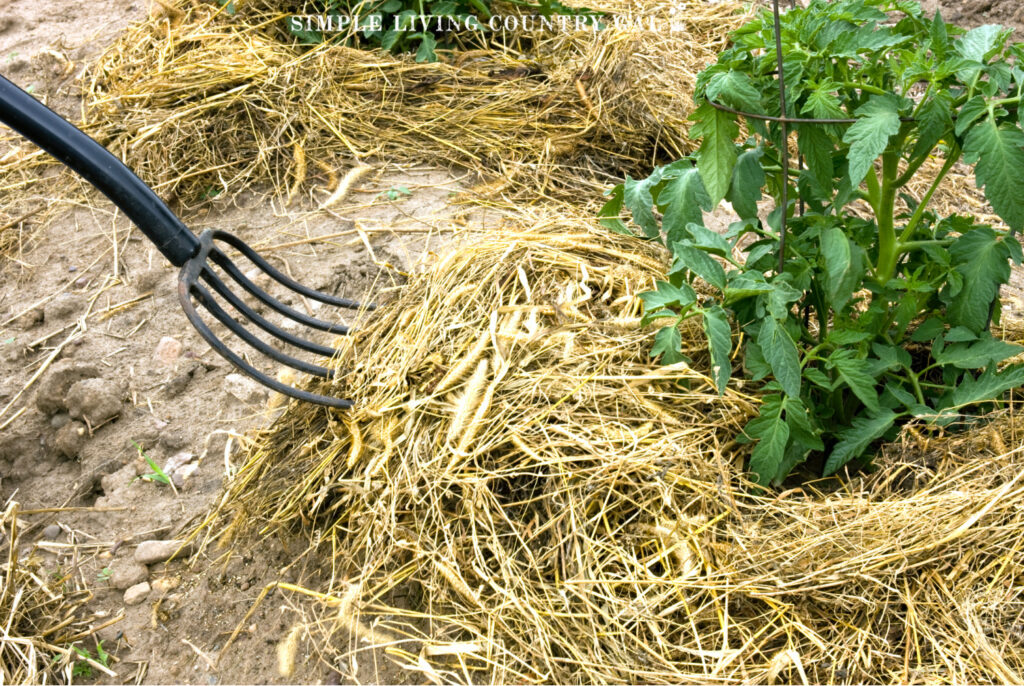
READ: THE BENEFITS OF MULCHING YOUR GARDEN
If you don’t think what you put around your plant matters, please read on.
Early on, I told you of a big faux pas I made when I started out on my own gardening journey. I used hay to mulch around my plants rather than using straw. Yes, the protection part is the same regardless of your choice, but the after-effects can be pretty costly.
Remember earlier we talked about the makeup of both straw and hay? Straw is basically the stem of the plant only whereas hay has the plant, the flower, the seed, all of it. So, if you choose to use hay around your plants you are in a sense, sprinkling the soil in your garden with a large and ample supply of seeds. And those seeds after watered throughout the summer growing season are also going to grow, grow, and GROW.
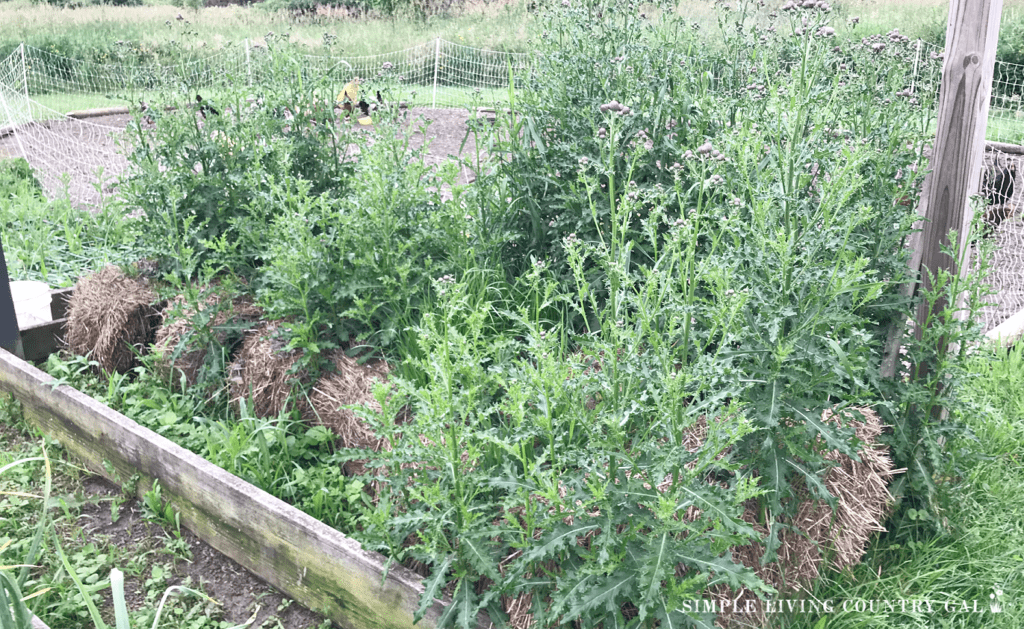
Although the quality is awful, the picture above tells my tale accurately. I used hay in my garden and ended up with so many weeds and briars that spread all over the west pasture that I never used hay in my gardens again.
This was a hard lesson that I learned, so take my advice. If you do not want to be faced with more weeds than tomatoes, you will want to always use straw in your garden and compost bin.
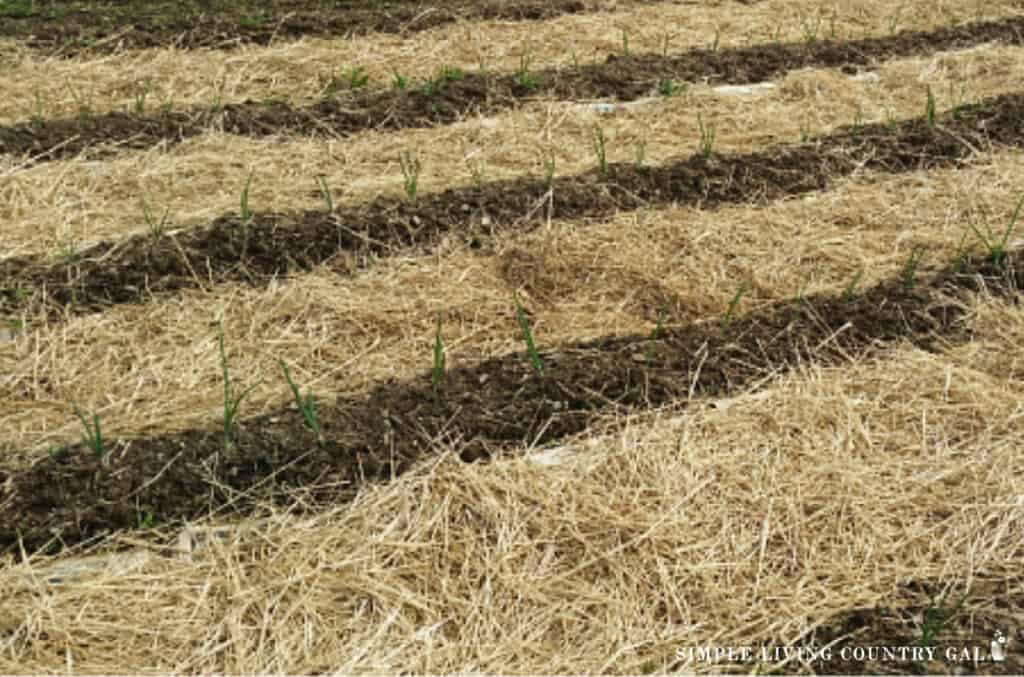
Can you put straw in a compost bin?
Yes, used or fresh straw can go into your compost bin. This is called brown matter, and it helps all the layers break down, turning it into compost that you can use anywhere you grow.
If you use straw as mulch in your garden, you have a few choices at the end of the growing season.
#1. Work the straw back into the soil and let it sit over the winter.
#2. Rake it up and put it into your garden’s compost bin.
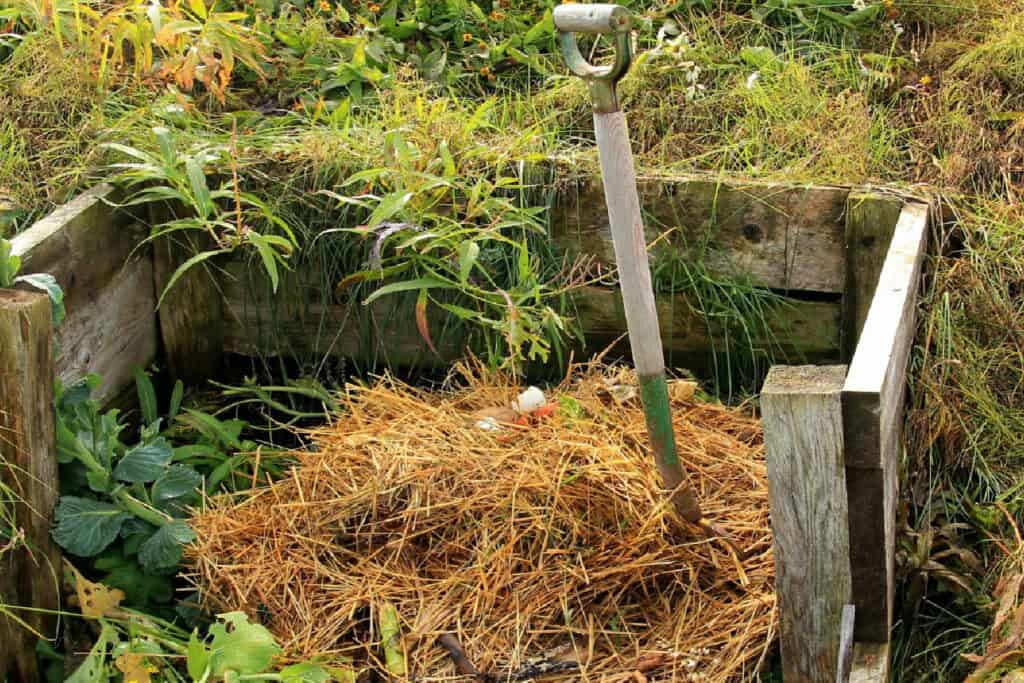
If you do not yet have a compost bin, you may want to add that to your spring project list. Compost is a great additive for your garden and the more you can mix and cook on your own the more you will know just how good the compost quality is for your garden soil.
READ: HOW TO COMPOST IN YOUR OWN BACK YARD
#2. Using straw as bedding
As I said earlier when bedding up animals it is always best to use straw. This will deter them from eating their bedding which can be soiled or dirty. A few bedding areas for straw are:
- Goat kidding pens
- Sick bays
- Animal stalls
- Chicken nesting boxes
- Rabbit hutches
#3. Using straw bales to grow in
A new way that I love to garden is with straw bales. To quickly explain what that is, instead of using a tilled-up portion of your land to grow a garden, you are transforming a straw bale into one.
This is an excellent solution for anyone who is short on space or has health limitations such as a bad back or walking issues.
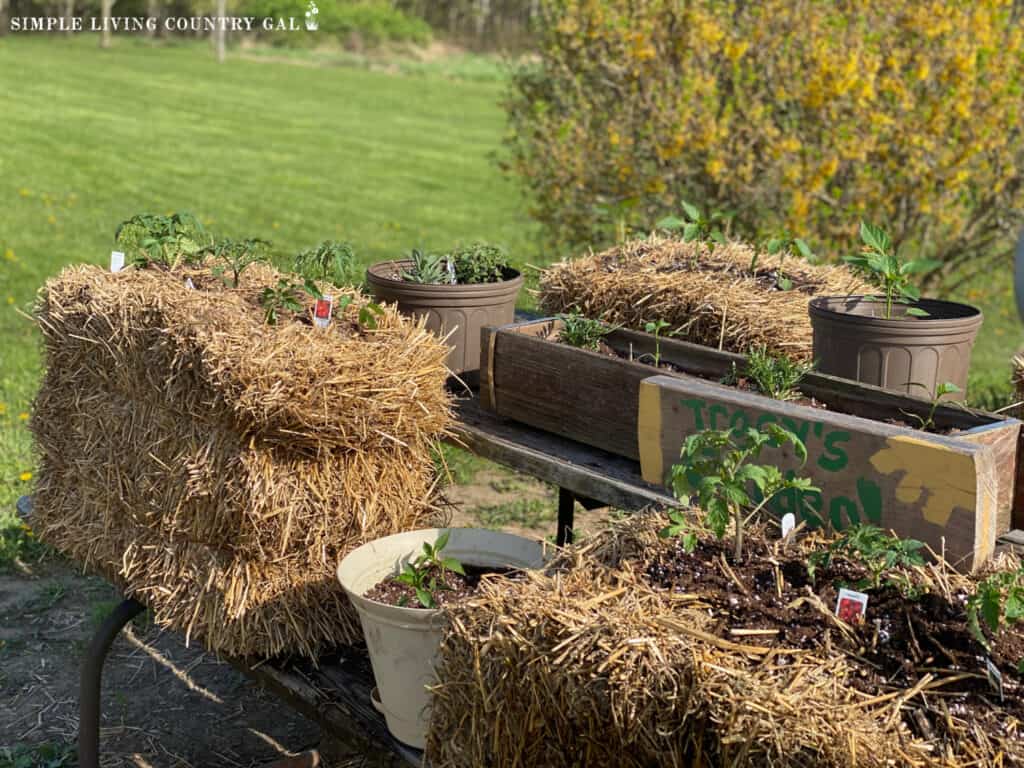
By using a straw bale as your garden, you are more able to get that garden closer to your home, where it is more convenient to care for. If you want to learn more about straw bale gardening, you can check out these helpful articles.
- What is Straw Bale Gardening
- Best Plants for Straw Bale Gardening
- How to Prepare Straw Bales for Planting
As homesteaders, the more we can do at home, the more we save. Educate yourself on the tools you use from start to finish so you use them all in the best way.
Knowing the difference between hay and straw will help you in all aspects of homesteading ensuring you are feeding the very best and gardening with the very best.





Thanks for sharing that! My only question is how do you know if the folks you are buying from are selling hay or straw? Some feed stores here sell “hay” that looks a lot more like straw. Just curious!
Great question, Kim!
Usually, you will need to inspect a bale to be sure. Hay tends to be a much firmer set of stalks/stems and is very yellow almost gold in color. Whereas hay is softer and much thinner in the stem, easy in a way to bend. Hay smells more like grass and has a green color to it. Just an FYI, good hay really good 2-3 cut crop hay…smells absolutely amazing. I can’t explain it but it is so soft and so fragrant that you just know it is good hay your animals will love. 🙂
I hope that helps!
Tracy